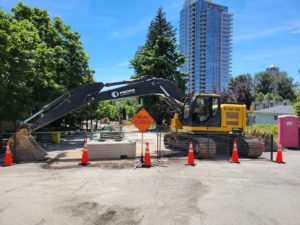
Public officials about to launch large infrastructure projects need to know as much as possible about Regional Infrastructure Accelerators (RIAs). Private sector companies interested in participating in infrastructure projects should also understand this relatively new federal program because there were only two objectives when it was created–to incentivize collaborative initiatives and ensure success for infrastructure projects.
Federal USDOT officials announced this past week that five new regional accelerators in various parts of the country have now received RIA designation and millions in federal funding. The objective of each of the five RIAs is to provide assistance in the form of funding and expertise as infrastructure projects are launched.
Funding was recently allocated to the Central Ohio Transit Authority (COTA); the New Mexico Trade RIA in Dona Ana County, New Mexico; the Panhandle Regional Planning Commission (PRPC) in Texas; the Resilient SR 37 Program in California; and the Midway Crossing Project in New York’s Suffolk County.
The RIAs will make available hundreds of millions of dollars for critical infrastructure projects and help to expedite project delivery. The funding is available through long-term, low-interest federal loans and it is designed to attract private sector investment in public-private partnerships. The following examples of infrastructure projects receiving RIA assistance are representative of what to expect soon throughout the country.
A $750,000 allocation of funds to COTA will be used by officials in the city of Columbus to deliver a connected, more equitable and efficient vision for transportation infrastructure. COTA has a long-term LinkUS Mobility plan that includes regional partners. The plan will ultimately deliver three new high-capacity rapid transit corridors at a cost likely to exceed $800 million.
The first project will be development of an East Main Corridor, which is currently about 15 percent of the way through engineering and design. The corridor will stretch 13 miles at a cost of $225 million and construction is scheduled for early in 2024.
Another $185 million project that will be launched by COTA is one that will deliver an 8.5-mile street corridor between downtown Columbus and the township of Prairie. Public transit buses on the corridor will serve 16 rapid transit stations along the way and the project is scheduled to launch in 2024.
The last of these upcoming COTA projects will accelerate delivery of the Northwest Corridor Plan. This project has a projected cost of $400 million. Engineering and design work is scheduled for late 2022. Detailed plans are available now for interested contracting firms.
The New Mexico Trade IRA in Dona Ana County will allocate $1.1 million to the planning process for a new logistics district on the US-Mexico border. As the project sponsor, New Mexico Trade IRA will work with partners across several jurisdictions in the region to create a TradePort and complementary infrastructure. An earlier study placed an estimated cost of $170 million on the project. There will be additional enhancements to ensure that the New Mexico TradePort remains commercially viable. Tentative plans outline additional features such as a $24 million earmark for a Santa Teresa Jetport and a new $40 million road that links the port of entry to prominent transportation corridors.
The Texas Panhandle Regional Planning Commission (PRPC) has $455,000 in federal funding to plan and accelerate rail and road enhancements. The plan will focus on enhancing mobility with a widened and upgraded network of roads linking counties in the Texas panhandle. The first project will be to provide assistance for roadway modernization. An $84 million freeway conversion initiative scoped for a segment of Amarillo Loop in the Texas panhandle is of immediate focus. After that project is out for bids the PRPC will focus on two other large road modernization projects. Texas’s newly formed RIA plans to convert a road in Moore County to a four-lane divided highway and estimated cost has been placed at $110.9 million. The PRPC also plans to expand a transportation corridor in Randall County at a projected cost of $133 million.
In California, an award of $1.5 million will be used to develop components of an infrastructure project that will span several counties in the Bay Area. The Metropolitan Planning Commission in California is leading the effort to build a 20-mile stretch of highway that will focus on concerns about flood protection, sea-level rise, and regional connectivity. Another project will be launched to improve roadway from Sears Point to Mare Island at a cost of about $430 million. The plan also includes rehabilitation of the Petaluma River Bridge, pavement enhancements, and a potential $1.5 billion causeway project.
New York’s RIA has allocated $1 million to support the planning stage for the Midway Crossing development in Suffolk County. Officials say that the initiative should generate $4.6 billion in annual economic impact once it is completed. With additional federal resources, the working group expects to deliver the project over four phases at a cost of approximately $2.8 billion. The plan calls for RIA support to accelerate construction of a 300-room hotel, a 300,000-square-foot convention center, design work for both a 1.7 million-square-foot office complex and a parking facility offering over 10,000 spaces.
These are examples of large infrastructure projects, but each will have an abundance of smaller contracting and subcontracting opportunities. The RIAs are offering extremely attractive incentives to private sector investors, and it is obvious that the federal government is encouraging private sector expertise and investment in ways that are likely to continue for decades. The types of projects described here represent examples of ones that are very likely to be replicated and standardized throughout the country.

